



















|
 |
|
 |

Here you can see units from a wide expanse of provinces, from Germania and the Alps in the west to the Ural Mountains in the east. These are the soldiers you will fight against should your armies move into the area and the soldiers you will recruit should you conquer the lands.
Gaizoz Alje (Celto-Germanic Spearmen)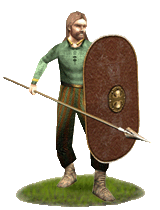 On the borders between Celtic and Germanic territories, the cultures overlap and give rise to troops that are a mesh of both cultures. These spearmen, the Gaizoz Alje ("Foreign Spears") are capable warriors who fight with long shields, javelins, and Celtic longspears that are excellent for killing horses. They throw javelins before charging, and can use their spears to absorb the shock of a cavalry rush. Their skills are a mix of Celtic and Germanic warfare and are a good addition to any army. On the borders between Celtic and Germanic territories, the cultures overlap and give rise to troops that are a mesh of both cultures. These spearmen, the Gaizoz Alje ("Foreign Spears") are capable warriors who fight with long shields, javelins, and Celtic longspears that are excellent for killing horses. They throw javelins before charging, and can use their spears to absorb the shock of a cavalry rush. Their skills are a mix of Celtic and Germanic warfare and are a good addition to any army.
Historically, as Celtic and Germanic cultures fought, traded, and intermarried, their cultures melded, creating unique sub-cultures and mixed tribes, with melds of tactics, weapons, and military philosophies. Such warriors were generally very fierce, and their armies built around infantry. The employ of lengthy spears was common to defeat enemy cavalry, though they could be used to effect against infantry as well. Warriors of this type actually persisted for quite a long time; even up to the fall of Rome, less-Romanized Britons under Anglo-Saxon rule or culture would have been fairly similar troops.
Gaizoz Frije (Germanic Levy Spearmen)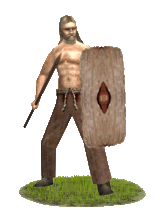 Gaizoz Frije ("One's own Spears"), whose name also means "Free Spears" are composed largely of local farmers and hunters, Germanic "free" men of the lowest rank, accustomed to frequent raids and tribal warfare from a young age. According to Germanic tradition, as soon as these men receive their gaizaz (spear) and skelduz (shield), they are frije ("free") adults, charged with equal shares and responsibilities in the tribe. Frije also came to mean "one's own," for to belong was to fulfill those duties of being "free." Gaizoz Frije ("One's own Spears"), whose name also means "Free Spears" are composed largely of local farmers and hunters, Germanic "free" men of the lowest rank, accustomed to frequent raids and tribal warfare from a young age. According to Germanic tradition, as soon as these men receive their gaizaz (spear) and skelduz (shield), they are frije ("free") adults, charged with equal shares and responsibilities in the tribe. Frije also came to mean "one's own," for to belong was to fulfill those duties of being "free."
Historically every "free" man of the Germanic tribes was a warrior, and expected to serve frequently in such a capacity. Though lacking in the organized training of the warbands that serve in a more regular capacity, these men are veterans of the ritualized tribal warfare within the amalgamation of German tribes, and fight with a force and fury superior to their neighbors’ militia.
Herunautoz (Germanic Swordsmen)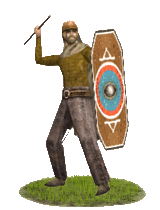 The Herunautoz ("Sword-possessors") come from such warlike tribes as the Heruskoz, Habukoz, Hattoz, and other numerous tribes of the Swêboz confederation. They are well trained, experienced and armed with superior quality swords and javelins to soften the enemy before their furious charge. The Herunautoz ("Sword-possessors") come from such warlike tribes as the Heruskoz, Habukoz, Hattoz, and other numerous tribes of the Swêboz confederation. They are well trained, experienced and armed with superior quality swords and javelins to soften the enemy before their furious charge.
Historically, swords were not plentiful in Germanic lands, because of the cost of the iron needed for a such a weapon, and so those fierce and valiant warriors carried their highly valued swords with pride. They fought in dense formations, often with their own kinsmen at their side. Often these warriors were aligned to the war-god Tiwaz as the sword was not only a weapon of esteem and regard for the Germanic tribes but also often used in religious ceremonies.
Jugunthiz (Germanic Skirmishers)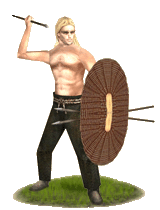 The Jugunthiz ("Youth") is a unit of lightly armed skirmisher troops who break up and harass enemy formations before the main battle lines meet, and act as a screen for heavy troops, taking losses in order to increase the odds of survival of more valuable "proven" warriors (Dugunthiz) who stand just behind. They must first prove themselves in battle in order to earn experience and status and fight beside their betters. Their skills also make them useful in springing tactical ambushes. Each warrior is armed with a bundle of throwing spears, a slightly longer spear for melee and a stout ovular shield, but they do not wear armor, being poor and of low status, but also choosing speed over protection. The Jugunthiz ("Youth") is a unit of lightly armed skirmisher troops who break up and harass enemy formations before the main battle lines meet, and act as a screen for heavy troops, taking losses in order to increase the odds of survival of more valuable "proven" warriors (Dugunthiz) who stand just behind. They must first prove themselves in battle in order to earn experience and status and fight beside their betters. Their skills also make them useful in springing tactical ambushes. Each warrior is armed with a bundle of throwing spears, a slightly longer spear for melee and a stout ovular shield, but they do not wear armor, being poor and of low status, but also choosing speed over protection.
Historically, the Jugunthiz are composed of a tribe’s young and inexperienced warriors. These men had yet to prove themselves as warriors, having had little practice in close combat, but like all Germanic warriors were eager to gain honor in the face of battle, and more steady skirmishers for it.
Skaduganganz (Germanic Naked Spearmen)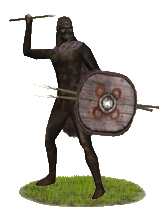 Skaduganganz ("Night-Walkers"), whose name also means "Shadow-goers" are unconventional warriors from the East who specialize in ambush. They display their zeal and innate ferocity with the help of pitch and dye by blackening their shields and bodies. They choose pitched nights for their battles and strike fear into the hearts of their enemies with the terrifying, "shadow"-like appearance of an army of the dead. When the moment is right, they charge wildly, wide-eyed and screaming at their foes. Any who survive assaults by these maniacal warriors are convinced they are spirits sent from the otherworld. Skaduganganz ("Night-Walkers"), whose name also means "Shadow-goers" are unconventional warriors from the East who specialize in ambush. They display their zeal and innate ferocity with the help of pitch and dye by blackening their shields and bodies. They choose pitched nights for their battles and strike fear into the hearts of their enemies with the terrifying, "shadow"-like appearance of an army of the dead. When the moment is right, they charge wildly, wide-eyed and screaming at their foes. Any who survive assaults by these maniacal warriors are convinced they are spirits sent from the otherworld.
Historically, Tacitus mentions this unqiue practice was used by a group called the Hariz (Harii), whose name means "Harrying ones" in their own language.
Skutjanz (Germanic Archers)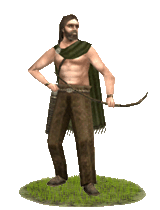 Skutjanz ("Shooters"), whose name also means "Marksmen" are equipped to harass and break up enemy formations so more experienced and valuable melee warriors can get in amongst their thinned ranks and finish them. Skutjanz are often untrained or uncapable warriors who guard the baggage train, but many are also excellect hunters or Germanic freemen of the lowest rank who cannot afford training or equipment. Skutjanz are also armed with the typical Germanic spear, which means that they can do a little more than other units of similar type in hand-to-hand combat and can act as light infantry in times of need. Their presence on a battlefield is always useful, as they have the flexibility to be both archers and infantry, but they will not last long in melee battle against opponents with superior training and protection. Skutjanz are at their best in wooded country, where their superior ambush skills, learned on the hunt, can be put to best use. Skutjanz ("Shooters"), whose name also means "Marksmen" are equipped to harass and break up enemy formations so more experienced and valuable melee warriors can get in amongst their thinned ranks and finish them. Skutjanz are often untrained or uncapable warriors who guard the baggage train, but many are also excellect hunters or Germanic freemen of the lowest rank who cannot afford training or equipment. Skutjanz are also armed with the typical Germanic spear, which means that they can do a little more than other units of similar type in hand-to-hand combat and can act as light infantry in times of need. Their presence on a battlefield is always useful, as they have the flexibility to be both archers and infantry, but they will not last long in melee battle against opponents with superior training and protection. Skutjanz are at their best in wooded country, where their superior ambush skills, learned on the hunt, can be put to best use.
Historically, Germanic bowmen on the battlefield were few in numbers, because weapons were status symbols and tools whose exclusive purpose was for war required more wealth and training than common multipurpose tools, such as the axe or bow. Yet all Germanic warriors were potential Skutjanz ("Marksmen"), having mastered hunting skills in dense and dark Germanic forests where their learned techniques of skulking and stalking serve them well. The Skutjanz use hunting bows which have only a short range, but each carries a good selection of hunting arrows, as well as war arrows, designed to cause massive bleeding and pierce armor respectively.
Druhtiz Habukisku (Chauci Spearmen)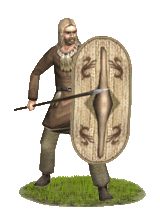 The Druhtiz Habukisku ("Chauci Warband") are local warriors, bound to their druhtinaz (war-leader), and organized into a druhtiz (warband) in his service. Though difficult to control, they are sincere in their desire for glory and plunder, and fight well to secure both. To this end, Druhtiz Habukisku are trained well in the burdahagon ("shield-wall") formation and perform better defensively than their neighbors. The Druhtiz Habukisku ("Chauci Warband") are local warriors, bound to their druhtinaz (war-leader), and organized into a druhtiz (warband) in his service. Though difficult to control, they are sincere in their desire for glory and plunder, and fight well to secure both. To this end, Druhtiz Habukisku are trained well in the burdahagon ("shield-wall") formation and perform better defensively than their neighbors.
Historically, the Habukoz (Chauci), whose name means "Hawks" in their own language, were a populous tribe inhabiting the extreme northwestern shore of Germania. Their warriors often used representations of birds on their clothing and shields. They were experienced sailors and just as often experienced pirates, but were always able to defend their lands with strength and valor.
Druhtiz Herusku (Cherusci Swordsmen)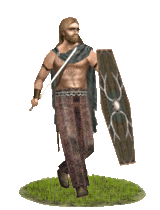 The Druhtiz Herusku ("Cherusci Warband") are fierce and hardy warriors, often serving under the command of an ambitious druhtinaz (king/war-leader). The Druhtiz Herusku can form a very dense shieldwall and are exceptional in defense. Many of their number possess swords and are rightly feared for their ability in melee combat and skirmishing. The Druhtiz Herusku ("Cherusci Warband") are fierce and hardy warriors, often serving under the command of an ambitious druhtinaz (king/war-leader). The Druhtiz Herusku can form a very dense shieldwall and are exceptional in defense. Many of their number possess swords and are rightly feared for their ability in melee combat and skirmishing.
Historically, the Heruskoz, whose name meant "Sword-ish ones" in their own language, were a Germanic tribe who inhabited the Rhine valley and the plains and forests of northwestern Germania. They were frequently at odds or allied with the Romans, as their individual political situation warranted, and made most famous by the Battle of the Teutoburg Forest, whence an army of allied Germanic tribes under the Cherusci war-leader Ermenaz ("Great one," more commonly known in Latin as Arminius) who annihilated three Roman legions commanded by Publius Quinctilius Varus.
This crushing Roman defeat stopped Rome's advance and compelled the empire, after a few more years of generally indecisive campaigning by Germanicus, to withdraw permanently behind the Limes fortification which was built as a consequence of the loss at Teutoburg Forest, to reinforce the German frontier.
Jugunthiz Hattisku (Chatti Club Infantry)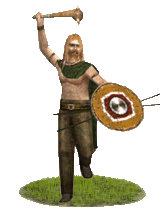 The Jugunthiz Hattisku ("Chatti Youth") is a unit of young and unproven warriors of the Hattoz (Chatti) tribe, who act as a screen and take losses to increase the odds of survival for more valuable "proven" troops (Dugunthiz). The Jugunthiz Hattisku are wild and reckless warriors, their courage and morale is undisputed as they are eager to prove themselves in battle, often to the detriment of the battle's outcome. Their chosen weapon is the cudgel, an appropriate weapon for their particular aim and vicious style of combat, eager to kill quickly and thoroughly. The Jugunthiz Hattisku ("Chatti Youth") is a unit of young and unproven warriors of the Hattoz (Chatti) tribe, who act as a screen and take losses to increase the odds of survival for more valuable "proven" troops (Dugunthiz). The Jugunthiz Hattisku are wild and reckless warriors, their courage and morale is undisputed as they are eager to prove themselves in battle, often to the detriment of the battle's outcome. Their chosen weapon is the cudgel, an appropriate weapon for their particular aim and vicious style of combat, eager to kill quickly and thoroughly.
Historically, the Hattoz (Chatti), which means "Ones who battle" in their own language, were a turbulent tribe who often clashed with the Romans and neighboring people. It was common for their young warriors not to shave their beards or cut their hair until they killed their first opponent in battle, thoroughly demonstrating what their societal expectations were within their tribe. A typical symbol of the battle oath they take is the iron ring worn around their neck which cannot be removed until they have committed man-slaughter, and more gruesomely, self-inflicted scars, ritualized body-art performed as they stand over the body of their fallen enemy.
Dugunthiz Hattisku (Chatti Spearmen)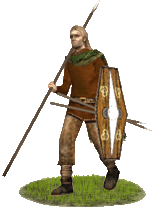 The Dugunthiz Hattisku ("Chatti Proven") is a unit of proud and experienced, "trusted" and "capable" warriors of the Hattoz (Chatti) tribe, steeled by years of constant warfare and "veterans" of numerous conflicts, mostly tribal, but some of a larger scale. These men are hardened for battle and unlikely to flee from conflict, and are trained through long experience to work in close or open formation, and even the burdahagon ("shieldwall"). Their courage and morale is unrefutable as they have "proven" themselves in battle and earned the right to use their gaizaz (spear). The Dugunthiz Hattisku ("Chatti Proven") is a unit of proud and experienced, "trusted" and "capable" warriors of the Hattoz (Chatti) tribe, steeled by years of constant warfare and "veterans" of numerous conflicts, mostly tribal, but some of a larger scale. These men are hardened for battle and unlikely to flee from conflict, and are trained through long experience to work in close or open formation, and even the burdahagon ("shieldwall"). Their courage and morale is unrefutable as they have "proven" themselves in battle and earned the right to use their gaizaz (spear).
Historically, the Hattoz (Chatti), which means "Ones who battle" in their own language, were a turbulent tribe who often clashed with the Romans and neighboring people. It was common for their young warriors not to shave their beards or cut their hair until they killed their first opponent in battle, thoroughly demonstrating what their societal expectations were within their tribe. A typical symbol of the battle oath they take is the iron ring worn around their neck which cannot be removed until they have committed man-slaughter, and more gruesomely, self-inflicted scars, ritualized body-art performed as they stand over the body of their fallen enemy.
Druhtiz Skandzisku (Scandinavian Spearmen)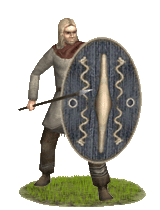 Skándzá (Scandinavia) and Auwjogotánoz (Gotland) are lands with a harsh climate and their people are accustomed to fighting everyday for their own survival. The Druhtiz Skandzisku ("Scandinavian Warband") composed of these tribes is full of fierce and hardy fighters, seeking glory and loot along their route on the war path, but are difficult to control for tactical maneuvering. In warfare it is up to each man to prove his own bravery and worth, so their uniquely savage charge into the enemy enables them to perform slightly better than their neighbors in that respect.
Skándzá (Scandinavia) and Auwjogotánoz (Gotland) are lands with a harsh climate and their people are accustomed to fighting everyday for their own survival. The Druhtiz Skandzisku ("Scandinavian Warband") composed of these tribes is full of fierce and hardy fighters, seeking glory and loot along their route on the war path, but are difficult to control for tactical maneuvering. In warfare it is up to each man to prove his own bravery and worth, so their uniquely savage charge into the enemy enables them to perform slightly better than their neighbors in that respect.
Historically, Scandinavia was also homeland to some of the mainland Germanic tribes. The tribes of the North continued fighting in the druhtiz (warband) style, forming a single armed entity and relying on their individual superiority as warriors to carry the day. Similar tactics are used by many other barbarian peoples, but Germanic warriors use a much denser formation that is far more difficult to break.
Ridanz (Germanic Light Cavalry)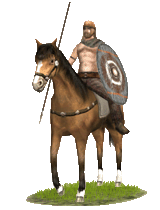 Ridanz ("Riders") ride small and sometimes poor quality horses, though they are excellent light cavalry. They are useful as scouts as well as skirmishers. Like many Germanic warriors, however, they can lack battle-discipline and be over-keen to enter battle against worthy opponents. This can lead them to be headstrong, and difficult to restrain before a fight, as personal glory gained in battle is always welcome. Honor and standing come from fighting, and sometimes the urge for glory overwhelms their good sense! Ridanz ("Riders") ride small and sometimes poor quality horses, though they are excellent light cavalry. They are useful as scouts as well as skirmishers. Like many Germanic warriors, however, they can lack battle-discipline and be over-keen to enter battle against worthy opponents. This can lead them to be headstrong, and difficult to restrain before a fight, as personal glory gained in battle is always welcome. Honor and standing come from fighting, and sometimes the urge for glory overwhelms their good sense!
Historically, Germanic tribes did not frequently use cavalry and their warriors mainly fought on foot, however, some tribes were known for their use of cavalry and many peoples praised the good quality of Germanic cavalry. Though the horses that were used by the Germanic tribes were not exceptional, Germanic horsemen could still maneuver very well and operated as a unit, rather than as an unorganized band.
These early Germanic horsemen did not use saddles by choice, nor stirrups because they were unknown in Europe at that time, later introduced by invading peoples from the east. The Germanic tribes were among the first peoples to copy the stirrup because they recognized its potential, for with a stirrup the warrior could not only mount his horse more easily but he could also "step up" on his horse to throw a spear. They were mostly armed with shield and spear and were supported by fast-moving light infantry - this light cavalry combined with light infantry allowed great tactical speed and versatility on the battlefield; the cavalry could break through enemy lines while the infantry quickly followed behind to finish off any remaining enemy soldiers.
Kluddacorii (Alpine Shortswordsmen)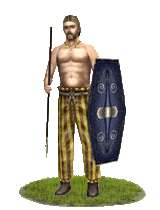 Tribes from the Alps and some nearby territories have swordsmen of their own, the Kluddacorii (Klod-ah-kur-ee-eye; Sword-Band). The swords in such places have a broader, somewhat shorter blade, reminiscent of much older styles of sword. These men often wear little in a battle, removing anything that might act as a hinderance but for trousers and their shoes much of the time, and fight using a powerful charge in an attempt to overwhelm an enemy position, or break a gap in an opposing line, after throwing their javelins. Such tribes are high-spirited and very eager to fight given the chance, so they have decent morale, but their lack of armor is a detriment in a prolonged engagement, or if they should be flanked. The territories they come from have allowed them experience fighting in woods and hills where they have grown accustom to techniques for ambushing if they have to. Tribes from the Alps and some nearby territories have swordsmen of their own, the Kluddacorii (Klod-ah-kur-ee-eye; Sword-Band). The swords in such places have a broader, somewhat shorter blade, reminiscent of much older styles of sword. These men often wear little in a battle, removing anything that might act as a hinderance but for trousers and their shoes much of the time, and fight using a powerful charge in an attempt to overwhelm an enemy position, or break a gap in an opposing line, after throwing their javelins. Such tribes are high-spirited and very eager to fight given the chance, so they have decent morale, but their lack of armor is a detriment in a prolonged engagement, or if they should be flanked. The territories they come from have allowed them experience fighting in woods and hills where they have grown accustom to techniques for ambushing if they have to.
Historically, the Alpine tribes, at least, the well-developed ones, and some of their neighbors, used weaponry that was in an older-style long after other Celts had been moving toward newer designs. This does not mean they were of poorer quality though; the Noricans had famously strong, high-quality weapons. It simply means the appearance recalled an earlier time in their development. Such swords are shorter, with a sharp point, and a broad-base, making the blade almost triangular, such as was common of Celtic daggers and knives. Warriors carrying such swords would not have to be exceedingly wealthy, and likely would fall into the middle class, composed of professional and semi-professional warriors, adventurers, and mercenaries.
Caturige Gaedann (Caturiges Warriors)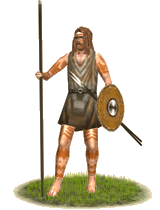 The Gaedann (Guy-dun; "Spear Carriers") are warriors of the savage and fierce Caturiges. These alpine warriors are hardy and capable of shattering enemies with a fierce charge. They employ javelins and thrusting spears, and defend themselves with fair quality shields, and Celtic bronze chest plates. In the employ of others, they can be used to fill combat roles of both shock infantry, and ambushers in more heavily forested regions. However, they are very undisciplined and prone to charging before ordered to do so, which can be unhelpful at times.
The Gaedann (Guy-dun; "Spear Carriers") are warriors of the savage and fierce Caturiges. These alpine warriors are hardy and capable of shattering enemies with a fierce charge. They employ javelins and thrusting spears, and defend themselves with fair quality shields, and Celtic bronze chest plates. In the employ of others, they can be used to fill combat roles of both shock infantry, and ambushers in more heavily forested regions. However, they are very undisciplined and prone to charging before ordered to do so, which can be unhelpful at times.
Historically, alpine tribes in Gaul were always generally a bit behind or unusual in their development compared to their neighbors. This gave them a savage, uncivilized reputation; not necessarily a bad thing in combat. Despite this, some of these tribes developed reputations for rather civilized things, such as fine wines. All the same, these things are usually overshadowed by their reputation for brutality and eagerness to fight.
Mori Gaesum (Helvetii Phalanx)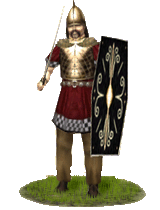 The Mori Gaesum ("Sea Of Spears") is an elite mercenary unit of Helvetii origin. The Helvetii tribes are more known for their fierceness than their unity. As such, much of the great warriors of each tribe sell their services to the highest bidders. Some of these men are used to face Hellenic armies and, consequently, have incorporated some of their enemy's tactics in to their own. The Mori Gaesum ("Sea Of Spears") is an elite mercenary unit of Helvetii origin. The Helvetii tribes are more known for their fierceness than their unity. As such, much of the great warriors of each tribe sell their services to the highest bidders. Some of these men are used to face Hellenic armies and, consequently, have incorporated some of their enemy's tactics in to their own.
They use the familiar phalanx tactic to engage and tire the enemies before switching to their sword and shield to finish them off. This method, together with their well known fierceness and skill, make them a frightening opponent for any enemy army.
Though not the equal of the Greeks or Macedonians in phalanx warfare, the Mori Gaesum can compensate that with superior swordsmanship, aggressiveness and experience.
Appea Gaedotos (Alpine Phalanx)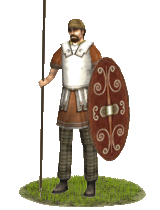 The alpine tribes experienced a great deal of influence from the Hellenes and Italians. The Appea Gaedotos (Ap-ee-ah Guy-doo-tos; Spear Carriers) use a type of spear wall, and carry a very bizarre shield, as well as a battle axe for close combat fighting. They are solid soldiers, and should be able to stand rather well in combat, and a phalanx is always good when combatting mounted enemies, as well as defending against light infantry. In close combat, their battle axes can crush through armor, making them very capable, and they wear linen armor of Etruscan design, so they are readily able to defend themselves. The alpine tribes experienced a great deal of influence from the Hellenes and Italians. The Appea Gaedotos (Ap-ee-ah Guy-doo-tos; Spear Carriers) use a type of spear wall, and carry a very bizarre shield, as well as a battle axe for close combat fighting. They are solid soldiers, and should be able to stand rather well in combat, and a phalanx is always good when combatting mounted enemies, as well as defending against light infantry. In close combat, their battle axes can crush through armor, making them very capable, and they wear linen armor of Etruscan design, so they are readily able to defend themselves.
Historically, the Alps were home to many tribes, both Celtic and non-Celtic. Both, however, used a share of one another's weapons, as well as weapons and tactics from Greece and the Italian peninsula. These soldiers would be, in essence, a type of imitation hoplite, with influences from the alpine tribes. Due to their climate, they would've been very hardy soldiers; coupled with their culture, which glorified combat to a great extent, these would have been truly fearsome warriors.
Noricene Gaecori (Noricum Spearmen)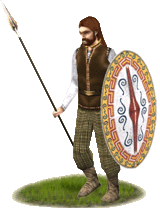 Noricene Gaecorii (Guy-kur-ee-eye; "Spear Troop") are a product of Celtic, Italic, and Hellenistic influences present in Noricum. They are essentially a Celtic warband, but their oval shield is reinforced. These men are semi-professional soldiers, not levies, despite their simple armaments. They are from the mountains, and, as such, are more resilient to the natural elements than most, and are quite hardy. Their throwing spears aren't of the greatest quality, but they can soften an enemy before they charge. Noricene Gaecorii (Guy-kur-ee-eye; "Spear Troop") are a product of Celtic, Italic, and Hellenistic influences present in Noricum. They are essentially a Celtic warband, but their oval shield is reinforced. These men are semi-professional soldiers, not levies, despite their simple armaments. They are from the mountains, and, as such, are more resilient to the natural elements than most, and are quite hardy. Their throwing spears aren't of the greatest quality, but they can soften an enemy before they charge.
Historically, Noricum was the product of a Celtic culture absorbing many Hellenic and Italic influences. They were very much Celtic, but the clear Hellenic and Italic influences evidenced themselves in the use of various phalanx tactics they used, and linothorax armor, as well as other developments. These warriors were 'basic' soldiers, but comparatively well trained compared to other Celtic warbands. They would be well trained and somewhat disciplined, and capable of softening foes before the actual soldiers engaged them, or engaging lighter enemies by themselves.
Tekastos (Rhaetic Axemen)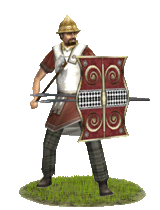 The Raetians are a very bizarre alpine people; raiders often, and have repeatedly attracted ire from Celts. The Tekastos (tek-as-tus; Axe Carriers) form the basic warbands of the Raetians. They carry a Raetian battle axe to crush through armor, and two javelins in the manner of Italic pila, and wear linen armor of Etruscan design, as well as a helmet. This sturdy, unique warband can be very useful as shock troops, with weapons made to allow them to stand against superiorly armored enemies. The Raetians are a very bizarre alpine people; raiders often, and have repeatedly attracted ire from Celts. The Tekastos (tek-as-tus; Axe Carriers) form the basic warbands of the Raetians. They carry a Raetian battle axe to crush through armor, and two javelins in the manner of Italic pila, and wear linen armor of Etruscan design, as well as a helmet. This sturdy, unique warband can be very useful as shock troops, with weapons made to allow them to stand against superiorly armored enemies.
Historically, the Raetians were a collection of tribes in the Alps. They were famed for the quality of their wine, but were mostly treated with no small amount of distaste and ire. Like other enemies of the Celts, they adopted many Celtic weapons and pieces of armor out of a necessity to modernize to new threats. However, they also had a great deal of unique looking equipment; meshes of Italic, Hellenic, Celtic, and Hallstatt influences, and were especially fond of their own local axes, which varied between a number of designs.
Cordinau Orca (Scordisci Elite Infantry)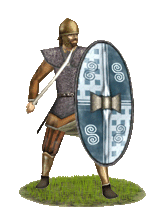 The Scordisci are Celtic warriors who live near Macedonia. They are famous for their use of sheering curved swords that can open wide gashes on an opponent, particularly when used by the fearsome Carduci tribe, who are most famous for them. Like the Solduros of the Gauls, in the east, the Carduci have the Cordinau Orca (Kor-dee-now Urk-ah; Battle Boars), the guardians of their chief, and fearsome, strong warriors. They are impetuous soldiers, and prone to charging without being ordered, but they are comparatively bold to many other Celtic warriors, and their bravery in combat allows them to overcome seemingly superior forces in some cases, and immense skill with their shields and swords makes them notable. The Scordisci are Celtic warriors who live near Macedonia. They are famous for their use of sheering curved swords that can open wide gashes on an opponent, particularly when used by the fearsome Carduci tribe, who are most famous for them. Like the Solduros of the Gauls, in the east, the Carduci have the Cordinau Orca (Kor-dee-now Urk-ah; Battle Boars), the guardians of their chief, and fearsome, strong warriors. They are impetuous soldiers, and prone to charging without being ordered, but they are comparatively bold to many other Celtic warriors, and their bravery in combat allows them to overcome seemingly superior forces in some cases, and immense skill with their shields and swords makes them notable.
Historically, the Scordisci were a rather extroverted Celtic people; they were so cosmopolitan that their enemies sometimes thought them Thracians or Illyrians. This may be because of their common alliances with the Macedonians; in fact, much of their fame spread from their service to Macedonians, and later they destroyed the army of Caius Porcius Cato, while trying to reestablish their Macedonian allies, who had become a Roman province. They were more or less defeated by Minucius Rufus in 107, but they continued to raid from near the Danube for a long time, until essentially conquered by 91 BC, when many of them fled north over the Danube or submitted to Roman rule, though they still managed to sack Delphi. The remaining Scordisci were most likely absorbed or overrun by Dacians.
Boii Cingetos (Boii Swordsmen)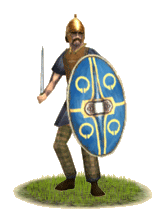 The Boii Cingetos (Kin-jet-os; "Marchers") are professional warriors from the Boii homelands. These men fight in the familiar Celtic fashion, but carry slashing and thrusting broad-bladed swords, a weapon not so common among Celts. They are fairly well-defended from attack, with leather cuirass and good quality helmet with earguards, and a Celtic longshield. Prior to a charge, like other Celtic warriors, the Boii unleash a barrage of javelins to soften their target. In a melee, their swords are of excellent use, being highly versatile with a good slashing edge and a tapered point, good for thrusting or finding a weak spot in an enemy's armor. Further, compared to most other Celts, the Boii are more prone to stricter discipline, tempered by centuries of incessant combat with neighbors.
The Boii Cingetos (Kin-jet-os; "Marchers") are professional warriors from the Boii homelands. These men fight in the familiar Celtic fashion, but carry slashing and thrusting broad-bladed swords, a weapon not so common among Celts. They are fairly well-defended from attack, with leather cuirass and good quality helmet with earguards, and a Celtic longshield. Prior to a charge, like other Celtic warriors, the Boii unleash a barrage of javelins to soften their target. In a melee, their swords are of excellent use, being highly versatile with a good slashing edge and a tapered point, good for thrusting or finding a weak spot in an enemy's armor. Further, compared to most other Celts, the Boii are more prone to stricter discipline, tempered by centuries of incessant combat with neighbors.
Historically, the Boii of central and eastern Europe are one of the oldest and most numerous of the Celtic peoples, actually composed of dozens of tribes that all answer to the name Boii, either from common ancestry or from being conquered by them at some point in the past. The Boii also have the distinction of being the first people known to have called themselves Celtae. Members of their tribes also joined the Galatians on their invasions of Greece and settlement of Asia Minor. They absorbed numerous influences, as well as influenced their neighbors, causing them to diverge somewhat in appearance from the Celts of western Europe.
Kludda Lugiae (Lugian Swordsmen)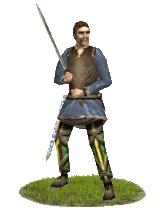 The La Tene Celts were extremely skilled iron workers. One of their greater weapons produced were the two-handed swords; a Celtic longsword with an elongated grip and a heavier blade. Used mainly by the Lugians, they also were used rarely by Gauls, and a modified, heavier weight version was used by the Britons. The Kludda Lugiae ("Swords of the Lugians") are not necessarily the best outfitted, but their sword is good quality, and can do a great amount of damage. They require great mobility and space to use, meaning the wielders don't organize into lines, but throw themselves at the enemy in a wide-spaced group. They were employed by many of the barbarian peoples who would take control of those regions their swords were produced in, for their great effectiveness, and the veteran status of these warriors ensured they worked hard, and weren't afraid of combat. The La Tene Celts were extremely skilled iron workers. One of their greater weapons produced were the two-handed swords; a Celtic longsword with an elongated grip and a heavier blade. Used mainly by the Lugians, they also were used rarely by Gauls, and a modified, heavier weight version was used by the Britons. The Kludda Lugiae ("Swords of the Lugians") are not necessarily the best outfitted, but their sword is good quality, and can do a great amount of damage. They require great mobility and space to use, meaning the wielders don't organize into lines, but throw themselves at the enemy in a wide-spaced group. They were employed by many of the barbarian peoples who would take control of those regions their swords were produced in, for their great effectiveness, and the veteran status of these warriors ensured they worked hard, and weren't afraid of combat.
Historically, La Tene two-handed swords were used in several regions, but were not overly popularized. They were expensive, and difficult to make, and the method of using such weapons often disallowed the wearing of much armor, due to the width of the swings, which required one to have good mobility around the shoulders. A variant of these swords was used by the wealthiest of Britons, who were armored. However, Lugians, wore lighter padding or leather, or even no armor at all. They would be utilized as shock soldiers, using their swords to attack large numbers of lighter armed infantry, striking several opponents in wide swings.
Karotovas (Oksywie Culture Swordsmen) The Karotovas (Kar-ot-oh-vus; 'Fighting Men') are the wealthier warriors of some of the tribes around the south of the Baltic sea, and in neighboring regions. Possessing neither great amounts of armor or iron weapons, these men are special. They carry decently made unique slashing swords, and can hit with a powerful, if heavily disordered charge. Due to disorder, they can be prone to charging at their own wont, regardless of prudence. The Karotovas (Kar-ot-oh-vus; 'Fighting Men') are the wealthier warriors of some of the tribes around the south of the Baltic sea, and in neighboring regions. Possessing neither great amounts of armor or iron weapons, these men are special. They carry decently made unique slashing swords, and can hit with a powerful, if heavily disordered charge. Due to disorder, they can be prone to charging at their own wont, regardless of prudence.
Historically, the early Baltic tribes varied widely in how developed they were. The southern Balts though, such as proto-Lithuanians and their neighbors, developed faster, being close to iron-working societies. The Oksywie culture of northern Poland was especially developing, along with the neighboring Przeworsk people. The result was Baltic and near-Baltic tribes of looser relationship to Germans and Celts than most other eastern European tribes, but with a more developed military than other Baltic tribes.
Marholeudiz Wolhiskoz (Celto-Germanic Cavalry)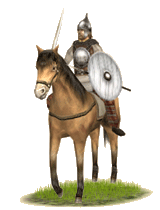 The Marholeudiz Wolhiskoz (MARH-o-LEUD-iz UWOLH-isk-oz, "East Celt Warhorse-Vassal") are an effective medium cavalry, drawn primarily from Germanic horsemen who have migrated into Celtic areas, and their descendents. They are bold horsemen, with skill in both skirmishing and melee, and are more heavily armored than their counterparts to the north, having benefited from their exposure to, and intermingling with, the cavalry contingents of subjugated and allied Celtic nations. With a simple breastplate and helmet enhancing their fierceness, they have staying power in melee against most other regular cavalry, but their javelins enable them to skirmish as well. They are best used to secure dominance in pre-battle skirmishing and on the flanks, before being used to break up weakened enemy formations.
The Marholeudiz Wolhiskoz (MARH-o-LEUD-iz UWOLH-isk-oz, "East Celt Warhorse-Vassal") are an effective medium cavalry, drawn primarily from Germanic horsemen who have migrated into Celtic areas, and their descendents. They are bold horsemen, with skill in both skirmishing and melee, and are more heavily armored than their counterparts to the north, having benefited from their exposure to, and intermingling with, the cavalry contingents of subjugated and allied Celtic nations. With a simple breastplate and helmet enhancing their fierceness, they have staying power in melee against most other regular cavalry, but their javelins enable them to skirmish as well. They are best used to secure dominance in pre-battle skirmishing and on the flanks, before being used to break up weakened enemy formations.
Historically, the cavalry of the Bononians, Pannonians, and Noricenes were slightly more heavily armored than most of their Germanic counterparts. Grave finds and depictions in art give us some idea of the sort of weapons they carried: simple breastplates and a variety of helmet types were the order of the day. When the Cimbri and Teutons migrated into the lands of the Lugians and Bononians, they allied with some of those eastern Celts and defeated others. When their armies eventually encountered the Romans, the description of their cavalry passed on through Roman history describes the material influence of the eastern Celts on the migrating Germanic tribes. If a Swebozez war leader can lead his warriors into the lands of the powerful east Celtic kingdoms, his own knightly warriors, the knightly aristocracy of the defeated Celts, and the descendants of both, can combine to form an effective cavalry force.
Karas Viras (Baltic Light Spearmen)
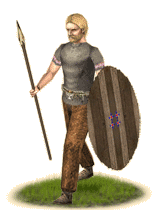 By 3rd century BC, the proto-baltic tribes inhabiting forest of eastern Europe already divided themselves into West and East Balts. There were already significant cultural differences between the two. The western ones came in contact with more civilized people of Europe, settled and begun excavating amber, the Gold of Baltic. Combined, this gave them civilization boost and set them apart from their eastern kindred. The eastern Balts, it is believed, remained semi-nomad, with rare, scattered settlements on hills. Mixed with Ugro-finnian tribes of the north, they traded textiles and products of forest with Scythians and Sarmatians. Even when roman traders arrive in these lands 300 years later, they note a difference between civilized Aesti, living on the coast, and nomad Fenni, living in the forest. By 3rd century BC, the proto-baltic tribes inhabiting forest of eastern Europe already divided themselves into West and East Balts. There were already significant cultural differences between the two. The western ones came in contact with more civilized people of Europe, settled and begun excavating amber, the Gold of Baltic. Combined, this gave them civilization boost and set them apart from their eastern kindred. The eastern Balts, it is believed, remained semi-nomad, with rare, scattered settlements on hills. Mixed with Ugro-finnian tribes of the north, they traded textiles and products of forest with Scythians and Sarmatians. Even when roman traders arrive in these lands 300 years later, they note a difference between civilized Aesti, living on the coast, and nomad Fenni, living in the forest.
Some tribes of the eastern Balts built fortified settlements on the hills within the forests. These settlements, called Gardas, had to have a class of warriors - Karas Viras - dedicated to defending them, and attacking other similar settlements. We don't know enough about these warriors to reconstruct them properly, but most probably, they were armed with wooden or bone-tipped spears, javelins, and bronze axes, as eastern Balts did not use much iron.
Kirslininkas (Baltic Light Infantry)
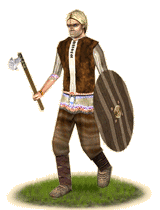 By 3rd century BC, the proto-baltic tribes inhabiting forest of eastern Europe already divided themselves into West and East Balts. There were already significant cultural differences between the two. The western ones came in contact with more civilized people of Europe, settled and begun excavating amber, the Gold of Baltic. Combined, this gave them civilization boost and set them apart from their eastern kindred. The eastern Balts, it is believed, remained semi-nomad, with rare, scattered settlements on hills. Mixed with Ugro-finnian tribes of the north, they traded textiles and products of forest with Scythians and Sarmatians. Even when roman traders arrive in these lands 300 years later, they note a difference between civilized Aesti, living on the coast, and nomad Fenni, living in the forest. By 3rd century BC, the proto-baltic tribes inhabiting forest of eastern Europe already divided themselves into West and East Balts. There were already significant cultural differences between the two. The western ones came in contact with more civilized people of Europe, settled and begun excavating amber, the Gold of Baltic. Combined, this gave them civilization boost and set them apart from their eastern kindred. The eastern Balts, it is believed, remained semi-nomad, with rare, scattered settlements on hills. Mixed with Ugro-finnian tribes of the north, they traded textiles and products of forest with Scythians and Sarmatians. Even when roman traders arrive in these lands 300 years later, they note a difference between civilized Aesti, living on the coast, and nomad Fenni, living in the forest.
The western Balts knew and used iron. Amber trade gave them wealth. Thus, they were probably able to field a regular army at time of need. Armed with iron-tipped spears and battle axes, the Kirslininkas (Axemen) took part in wars and battles of the northern lands, the tales of which are lost to us now.
Lankininkas (Baltic Archers)
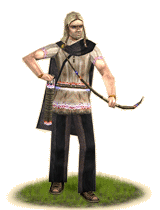 By 3rd century BC, the proto-baltic tribes inhabiting forest of eastern Europe already divided themselves into West and East Balts. There were already significant cultural differences between the two. The western ones came in contact with more civilized people of Europe, settled and begun excavating amber, the Gold of Baltic. Combined, this gave them civilization boost and set them apart from their eastern kindred. The eastern Balts, it is believed, remained semi-nomad, with rare, scattered settlements on hills. Mixed with Ugro-finnian tribes of the north, they traded textiles and products of forest with Scythians and Sarmatians. Even when roman traders arrive in these lands 300 years later, they note a difference between civilized Aesti, living on the coast, and nomad Fenni, living in the forest. By 3rd century BC, the proto-baltic tribes inhabiting forest of eastern Europe already divided themselves into West and East Balts. There were already significant cultural differences between the two. The western ones came in contact with more civilized people of Europe, settled and begun excavating amber, the Gold of Baltic. Combined, this gave them civilization boost and set them apart from their eastern kindred. The eastern Balts, it is believed, remained semi-nomad, with rare, scattered settlements on hills. Mixed with Ugro-finnian tribes of the north, they traded textiles and products of forest with Scythians and Sarmatians. Even when roman traders arrive in these lands 300 years later, they note a difference between civilized Aesti, living on the coast, and nomad Fenni, living in the forest.
The western Balts knew and used iron in considerate amounts. Amber trade gave them wealth. Thus, they were probably able to field a regular army at time of need. Armed with iron knives or axes, and hunting bows, the Lankininkas (Archers) took part in wars and battles of the northern lands, the tales of which are lost to us now.
Medininkas (Baltic Archers)
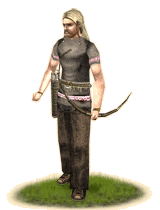 By 3rd century BC, the proto-baltic tribes inhabiting forest of eastern Europe already divided themselves into West and East Balts. There were already significant cultural differences between the two. The western ones came in contact with more civilized people of Europe, settled and begun excavating amber, the Gold of Baltic. Combined, this gave them civilization boost and set them apart from their eastern kindred. The eastern Balts, it is believed, remained semi-nomad, with rare, scattered settlements on hills. Mixed with Ugro-finnian tribes of the north, they traded textiles and products of forest with Scythians and Sarmatians. Even when roman traders arrive in these lands 300 years later, they note a difference between civilized Aesti, living on the coast, and nomad Fenni, living in the forest. By 3rd century BC, the proto-baltic tribes inhabiting forest of eastern Europe already divided themselves into West and East Balts. There were already significant cultural differences between the two. The western ones came in contact with more civilized people of Europe, settled and begun excavating amber, the Gold of Baltic. Combined, this gave them civilization boost and set them apart from their eastern kindred. The eastern Balts, it is believed, remained semi-nomad, with rare, scattered settlements on hills. Mixed with Ugro-finnian tribes of the north, they traded textiles and products of forest with Scythians and Sarmatians. Even when roman traders arrive in these lands 300 years later, they note a difference between civilized Aesti, living on the coast, and nomad Fenni, living in the forest.
In the deep forests of north-eastern Europe, life was hard for semi-nomadic tribes of eastern Balts. Small, scattered settlements did not form any states or nations, and they could not field regular armies. In need, packs of hunters could gather to defend their households, armed simply with their bows and knives, they couldn't stand long before organized enemy army.
Sauromatae Fistaeg Fat Aexsdzhytae (Sarmatian Foot Archers)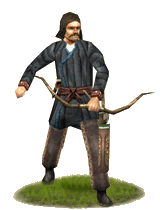 Unlike most other Sarmatians, many of the bowmen from Sarmatian groups that have become settled do not shoot their arrows from horseback, but fight on foot. Certainly, foot archers lack the mobility of their mounted counterparts. In exchange, men on foot need less space than those on horseback. Thus, foot archers can be deployed in tighter formations that provide heavier arrow barrages. And the composite bows that these foot archers employ maintain still the qualities of those of their nomadic relatives. Unlike most other Sarmatians, many of the bowmen from Sarmatian groups that have become settled do not shoot their arrows from horseback, but fight on foot. Certainly, foot archers lack the mobility of their mounted counterparts. In exchange, men on foot need less space than those on horseback. Thus, foot archers can be deployed in tighter formations that provide heavier arrow barrages. And the composite bows that these foot archers employ maintain still the qualities of those of their nomadic relatives.
Historically, several groups of Sarmatians became sedentary when they moved into areas (Ciscaucasia, the Hungarian Plain, etc.) where farming was a viable option to their traditional pastoral nomadism. The Siracae, for example, were a relatively small Sarmatian group that occupied the southern edges of the steppe along the Black Sea and in Ciscaucasia. Since quite early, they initiated a process of settlement and hellenization and, while still fielding armies with numerous cavalry, they resorted to infantry most than any other Sarmatians in the centuries BC. Presumably, the abundance of horsemen may have not been the only trace that steppe warfare left upon the ways of waging war of settled Sarmatians and substantial numbers of their infantry seem to have been archers using composite bows.
Sauromatae Fat Aexsdzhytae (Sarmatian Horse-Archers)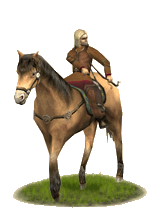 A swarm of nimble, mounted archers riding sturdy steppe ponies is the backbone of most Sarmatian armies and, if adequately handled, they can be a very effective force all by themselves. Most enemies will be slower or have a shorter range. The horse archers can keep peppering them with arrows for hours or days, evading if approached and closing in only when casualties and loss of cohesion have sufficiently weakened their foes. Typical horse archers, however, are not particularly well-suited for hand-to-hand combat. Armour and heavy weapons are expensive and so are the big horses that can deal with the added weight: only nobles and kings can afford such luxuries. Hence, typical horse archers carry little or no armour and are likely to suffer if forced into melee against most adversaries. A swarm of nimble, mounted archers riding sturdy steppe ponies is the backbone of most Sarmatian armies and, if adequately handled, they can be a very effective force all by themselves. Most enemies will be slower or have a shorter range. The horse archers can keep peppering them with arrows for hours or days, evading if approached and closing in only when casualties and loss of cohesion have sufficiently weakened their foes. Typical horse archers, however, are not particularly well-suited for hand-to-hand combat. Armour and heavy weapons are expensive and so are the big horses that can deal with the added weight: only nobles and kings can afford such luxuries. Hence, typical horse archers carry little or no armour and are likely to suffer if forced into melee against most adversaries.
Historically, life as nomadic herders on the steppe produced highly skilled bowmen and riders who could put those abilities to very good use on a battlefield. For over two millennia, these warriors were levied from the diverse nomads that roamed the vast Eurasian steppe and were a central and iconic component of their armies. Horse archer armies relied on mobility (at the strategic and tactical levels) and their excellent composite bows to win their battles and wars and their victories could be truly devastating. Both Macedonians and Romans at the peak of their military power saw some of their armies totally annihilated by enemies relying on horse archers and steppe tactics.
Ragon Sauromatae Uaezdaettae (Sarmatian Noble Horse-Archers)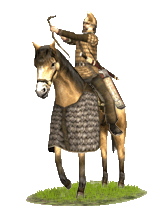 Sarmatian nobles are among the few in their society that can actually afford the very high costs of reasonably good defensive gear and of the larger horses which are able to carry a rider wearing such heavy equipment. Those expenses pay off by conferring them the ability to engage in hand-to-hand combat with some guaranties and, not to be forgotten, better looks than their less wealthy fellows. Nonetheless, in the early stages of the Sarmatian culture, even nobles carry only limited amounts of armour and are better thought of as medium or even light cavalry. Fortunately, they can still rely on their archery skills, in no way inferior to those of any other Sarmatian warrior and, although modest, the improvement in their equipment does allow them to carry out certain special tasks. Thus, they can fight enemy light cavalry with good prospects of victory. They can deal with enemy horse archers by either winning archery duels with them (thanks to their better armor) or by chasing them and beating them in melee (if they manage to catch them). They can also accelerate the collapse of enemy infantry still in relatively good shape through rear or flank charges and take good care of foot skirmishers. However, they are not prepared to frontally charge any decent close order infantry. Sarmatian nobles are among the few in their society that can actually afford the very high costs of reasonably good defensive gear and of the larger horses which are able to carry a rider wearing such heavy equipment. Those expenses pay off by conferring them the ability to engage in hand-to-hand combat with some guaranties and, not to be forgotten, better looks than their less wealthy fellows. Nonetheless, in the early stages of the Sarmatian culture, even nobles carry only limited amounts of armour and are better thought of as medium or even light cavalry. Fortunately, they can still rely on their archery skills, in no way inferior to those of any other Sarmatian warrior and, although modest, the improvement in their equipment does allow them to carry out certain special tasks. Thus, they can fight enemy light cavalry with good prospects of victory. They can deal with enemy horse archers by either winning archery duels with them (thanks to their better armor) or by chasing them and beating them in melee (if they manage to catch them). They can also accelerate the collapse of enemy infantry still in relatively good shape through rear or flank charges and take good care of foot skirmishers. However, they are not prepared to frontally charge any decent close order infantry.
Historically, the noble elite of the steppe nomads was able to afford better equipment for war and, thus, provided their armies with a core of heavier cavalry capable of hand-to-hand combat. How many of the nomads could afford the better gear and its amount and quality, depended on the wealth and access to resources such as mineral ore of each nomad group. Consequently, it varied substantially in space and time. In the particular case of the Ancient Sarmatian Culture, archaeological and literary sources suggest than metal armour was quite rare.
Skuda Fistaeg Fat Aexsdzhytae (Scythian Foot Archers)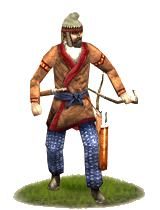 These Skythian archers often carry a slightly larger version of the composite bow that their fellow cavalrymen employ. This fact, together with the advantage of shooting from a more stable platform than a moving horse, tends to give their missiles somewhat longer range and more power than those typically shot by horse archers. To some extent, they compensate in this way for their comparative lack of mobility. Certainly, substantial numbers of foot bowmen can make sure that horse archers stay away from the area of the battlefield where they are deployed or inflict substantial damage on them, should they be foolish enough to engage in a protracted missile exchange. Of course, they will not be able to catch and destroy the elusive riders if the latter decide to avoid the arrow duel. In that regard, it is important that these archers are not lured too far away from supporting heavier infantry or cavalry whether in the pursuit of horse archers or for any other reason. They are not well outfitted for hand to hand combat, as all they carry is a short sword or small pickaxe and no armor but their thick jackets and bashlyk felt caps. If unsupported, they will be easy prey for cavalry, or aggressive infantry fast enough to catch them. These Skythian archers often carry a slightly larger version of the composite bow that their fellow cavalrymen employ. This fact, together with the advantage of shooting from a more stable platform than a moving horse, tends to give their missiles somewhat longer range and more power than those typically shot by horse archers. To some extent, they compensate in this way for their comparative lack of mobility. Certainly, substantial numbers of foot bowmen can make sure that horse archers stay away from the area of the battlefield where they are deployed or inflict substantial damage on them, should they be foolish enough to engage in a protracted missile exchange. Of course, they will not be able to catch and destroy the elusive riders if the latter decide to avoid the arrow duel. In that regard, it is important that these archers are not lured too far away from supporting heavier infantry or cavalry whether in the pursuit of horse archers or for any other reason. They are not well outfitted for hand to hand combat, as all they carry is a short sword or small pickaxe and no armor but their thick jackets and bashlyk felt caps. If unsupported, they will be easy prey for cavalry, or aggressive infantry fast enough to catch them.
Along their history, the Skythians of the northern coast of the Black Sea underwent a process of settlement and sedentarization. The phenomenon had started quite early, as Herodotos already spoke of farming Skythian groups, but it seems to have picked up pace as Sarmatian pressure pushed the Skythians out from much of their former lands and restricted them to a much reduced territory (the western part of the Crimea and the lower Dniepr) that could not have supported a large nomadic population. This process resulted in Skythian armies fielding increasing numbers of foot troops. A good portion of those seem to have been bowmen, as many settled Skythians still favored their traditional weapon.
Skuda Fat Aexsdzhytae (Scythian Horse-Archers)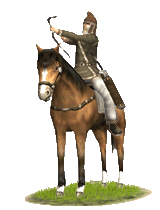 Scythian Horse Archers are not different to their many counterparts in their approach to battle. Only lightly protected and often with little more than a short sword as melee weapon, they rely instead in the power of their excellent composite bows and the speed and endurance of their sturdy steppe horses (and possibly the use of remounts). With these tools, they torment foes that cannot catch them or shoot back (or are outranged) with arrows until mounting casualties, exhaustion, sheer frustration and, perhaps, a rightly-timed charge by the core of heavier cavalry that often accompanies the horse archers, bring about the collapse of the enemy. Then, they will be eager to join in the pursuit and, thanks again to the speed of their mounts, they will be ruthlessly efficient in this task as well. Routing foes pursued by them have only very slim chances of escaping. As a part of a combined-arms army, they can harass an enemy, disrupt its formations and, with feigned flights, lure their troops to cunning ambushes. A judicious commander will seek to benefit from the strengths of Scythian Horse Archers and to minimize their weaknesses by deploying them in loose formations, in terrain that does not hamper their movement and by wisely keeping them out of hand-to-hand combat until the time is right. Scythian Horse Archers are not different to their many counterparts in their approach to battle. Only lightly protected and often with little more than a short sword as melee weapon, they rely instead in the power of their excellent composite bows and the speed and endurance of their sturdy steppe horses (and possibly the use of remounts). With these tools, they torment foes that cannot catch them or shoot back (or are outranged) with arrows until mounting casualties, exhaustion, sheer frustration and, perhaps, a rightly-timed charge by the core of heavier cavalry that often accompanies the horse archers, bring about the collapse of the enemy. Then, they will be eager to join in the pursuit and, thanks again to the speed of their mounts, they will be ruthlessly efficient in this task as well. Routing foes pursued by them have only very slim chances of escaping. As a part of a combined-arms army, they can harass an enemy, disrupt its formations and, with feigned flights, lure their troops to cunning ambushes. A judicious commander will seek to benefit from the strengths of Scythian Horse Archers and to minimize their weaknesses by deploying them in loose formations, in terrain that does not hamper their movement and by wisely keeping them out of hand-to-hand combat until the time is right.
Historically, the Scythians were largely responsible of first impressing on the minds of the settled peoples the image of the wild, steppe horse archer visiting destruction upon civilization. To some extent, they were preceded in this by the Cimmerians, but the extent and consequences of the Cimmerian invasions, large as they were, did not reach the scale of widespread devastation associated with the Scythians. In the 7th century BC after having subdued Media for some time and having contributed to the definitive fall of the Assyrian Empire, the Scythians poured over Mesopotamia, Western Asia Minor and the Near East ravaging and plundering as they went. Before crossing back the Caucasus and returning to the steppes, they would reach the very doors of Egypt, where Pharaoh Psammetichos paid a heavy tribute to see them depart. They wreaked major havoc that has left a diversity of lasting memories. The texts of the prophet Jeremiah in the Bible, the many Scythian trilobate arrowheads of cast bronze stuck in the brick walls of burnt cities over a very wide area, the writings of Herodotus or the city named Scythopolis (modern Beth-Shean in Israel) are some of the most conspicuous ones. Later, in the 6th century BC, Darius I, Great King of the Achaemenid Persian Empire, would claim retribution from past wrongs as the reason for his invasion of Scythian lands in the northern Black Sea coast. The invasion ended up in failure. Herodotos' account of that campaign is a textbook example (possibly the first recorded instance) of the application of the strategic retreat and scorched earth tactics and of the difficulties and dangers associated to fighting steppe nomads in their home turf.
Skuda Baexdzhyntae (Scythian Riders)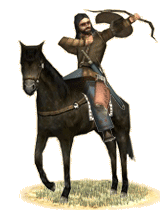 These light riders are from the Scythian tribes to the north of the Pontus Euxine (Black Sea). They rely on a long spear, bow and shield (typically, the crescent shaped, leather faced, Taka shield of the Scythian peoples) and are some of the most effective light horse available. There is also the long sword typical of the nomads, a Scytho-Sarmatian weapon with a ring-pommel. They are at their best when fighting in loose open formations, harassing the enemy, but ready in an instant to descend like lightning on any foe rendered vulnerable. Against unbroken infantry these light horsemen will prove of little value in a hand to hand clash and care should be taken not to waste them in such a way. These light riders are from the Scythian tribes to the north of the Pontus Euxine (Black Sea). They rely on a long spear, bow and shield (typically, the crescent shaped, leather faced, Taka shield of the Scythian peoples) and are some of the most effective light horse available. There is also the long sword typical of the nomads, a Scytho-Sarmatian weapon with a ring-pommel. They are at their best when fighting in loose open formations, harassing the enemy, but ready in an instant to descend like lightning on any foe rendered vulnerable. Against unbroken infantry these light horsemen will prove of little value in a hand to hand clash and care should be taken not to waste them in such a way.
Historically, during the 6th Century BC Persian invasion, the Scythian cavalry swept ahead of the invaders destroying anything of use to them. They led a Royal Achaemenid army into a futile chase across the steppe until overstretched Persian supply lines and scorched-earth tactics allowed them to turn from pursued into pursuers. The mauled Persian army managed to avoid destruction and regain the safe South bank of the Danube, but the Scythians had borne the brunt of Achaemenid might and had remained unconquered and masters of their lands. Also, even in their decline, they totally destroyed a 30,000 strong army sent by Zopyrion, one of Alexander’s generals, in 331 BC.
Skuda Uaezdaettae (Scythian Noble Cavalry)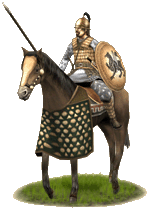 Although no longer the epitome of nomadic military ardor, the remnants of the Skythian nobility still serve as a powerful cavalry force. Now, the Skuda Uaezdaettae, or Skythian Nobles, fight in a matter almost more similar to the Greeks than their nomadic ancestors, preferring the xyston or spear and sword to archery, even though they still carry composite bows. Equipped with a fine lynothorax reinforced with metal scales, long pteryges and a Greek style bronze helmet, they can still form a deadly cavalry force, though not to the extent they once could. Their tactics have also shifted to deal more with similarly equipped cavalry and heavy infantry rather than nomadic horse archers. Although no longer the epitome of nomadic military ardor, the remnants of the Skythian nobility still serve as a powerful cavalry force. Now, the Skuda Uaezdaettae, or Skythian Nobles, fight in a matter almost more similar to the Greeks than their nomadic ancestors, preferring the xyston or spear and sword to archery, even though they still carry composite bows. Equipped with a fine lynothorax reinforced with metal scales, long pteryges and a Greek style bronze helmet, they can still form a deadly cavalry force, though not to the extent they once could. Their tactics have also shifted to deal more with similarly equipped cavalry and heavy infantry rather than nomadic horse archers.
Historically, after the Sauromatae began to invade their territory, the Skythians began to decline. Each year they shrunk, until they only continued in what became known as "Skythia Minor", the lower Dniepr and the Crimea. Because of this, their conections to the Hellenistic Black Sea colonies, which were always strong grew even greater until many Skythians were settled and resembled Greeks more than their nomadic cousins still on the steppe. Even so, they never completely lost their skill with cavalry and their martial prowess and under the rule of King Skiluros the Crimean Skythians experienced a revival of their fortunes. They gained control of the Greek city of Olbia and fought successfully against the Bosporan Kingdom. However, this prompted the intervention of a Pontic Kingdom that, under a young Mithradates VI was starting an agressive expansion. Pontic forces defeated the Skythians and made them vassals of Pontos. As such, they would become a very valuable asset for the Pontic army in its subsequent wars with Rome.
Aursa Baexdzhyntae (Aorsi Riders)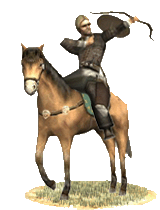 The Aursa Baexdzhyntae (Aorsi Riders) are the base of the armies fielded by the Aorsi, one of several major Sarmatian groups. Aorsi Riders are first and foremost horse archers, but, on average, Aorsi tribesmen are somewhat better equipped than their counterparts from other, earlier Sarmatian tribes. Thus, they often wear a measure of simple armor and tend to carry spears in addition to their bows. Hence, they can give a slightly better account of themselves if they find themselves engaged in hand-to-hand combat. Not that they will actively seek it, however. At least not against enemies whom archery fire, feigned retreats and sudden false charges have not thrown yet into utter confusion and demoralization. The Aursa Baexdzhyntae (Aorsi Riders) are the base of the armies fielded by the Aorsi, one of several major Sarmatian groups. Aorsi Riders are first and foremost horse archers, but, on average, Aorsi tribesmen are somewhat better equipped than their counterparts from other, earlier Sarmatian tribes. Thus, they often wear a measure of simple armor and tend to carry spears in addition to their bows. Hence, they can give a slightly better account of themselves if they find themselves engaged in hand-to-hand combat. Not that they will actively seek it, however. At least not against enemies whom archery fire, feigned retreats and sudden false charges have not thrown yet into utter confusion and demoralization.
Historically, the Aorsi were one of the most powerful Sarmatian confederacies. Though almost certainly a major exaggeration, Strabo credited the smaller of their two subdivisions with the capability of fielding an army of 200,000 riders. Also, graves ascribed to the Aorsi by the archaeologists attest to a certain prosperity and tend to be relatively well-equipped. In any case, their dominions extended east as far as the Caspian, or, probably, even the Aral Sea. In the west, they occupied the steppe between the Volga and Don rivers for a long time. Eventually, they moved west beyond the Don, pushed perhaps by the emergence of the Alans who might have absorbed or conquered many of them.
Aursa Uaezdaettae (Aorsi Noble Cavalry)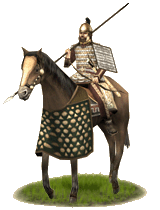 As is usual for most steppe nomads, nobility among the Aorsi have the means to equip themselves with more and better war gear than their followers. Metal armour, nonetheless, is still beyond the means of most Aorsi nobles and they must be content with either polished horn or hardened leather. Modest as they may initially seem, those materials confer nonetheless enough protection that Aorsi nobles may face a diversity of foes in hand-to-hand combat and expect to come out the victors. Their charges pack a distinct punch and their armour allows them to withstand both distant archery and melee against lightly armed foes reasonably well. However, they cannot expect to frontally charge infantry that has not been "softened" or to engage truly heavy cavalry and survive. Of course, true to steppe traditions, Aorsi nobles have not forsaken the composite bow and against such heavier enemies their skill as bowmen serves them very well. As is usual for most steppe nomads, nobility among the Aorsi have the means to equip themselves with more and better war gear than their followers. Metal armour, nonetheless, is still beyond the means of most Aorsi nobles and they must be content with either polished horn or hardened leather. Modest as they may initially seem, those materials confer nonetheless enough protection that Aorsi nobles may face a diversity of foes in hand-to-hand combat and expect to come out the victors. Their charges pack a distinct punch and their armour allows them to withstand both distant archery and melee against lightly armed foes reasonably well. However, they cannot expect to frontally charge infantry that has not been "softened" or to engage truly heavy cavalry and survive. Of course, true to steppe traditions, Aorsi nobles have not forsaken the composite bow and against such heavier enemies their skill as bowmen serves them very well.
Historically, Aorsi warfare remained firmly based on the horse archery tradition. Nonetheless, they, particularly their noble elite, also appear to have been somewhat better prepared for melee combat than earlier groups of Sarmatian peoples. It is not unconceivable that against more poorly equipped enemies they may have not been content with just winning archery duels thanks to their greater protection and may have actively sought to close in, so advantages in hand-to-hand offensive equipment may also be put to good use.
Rauxsa-alanna Baexdzhyntae (Roxolani Riders)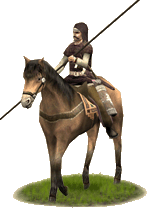 Lancers represent a shift of emphasis in Sarmatian warfare from mounted archery and attrition towards furious charges and shock combat. Equipped with the kontos, a long lance over 4 m long that they wield two-handed, and wearing good scale armour, Roxolani Riders can deliver a charge that few foes, mounted or foot, can withstand. A solid wall of pike or spear points will still be largely immune to such frontal attacks. However, many horse archers still fight alongside the lancers and the lancers themselves carry bows and are adept at the feigned flight and all the other steppe manoeuvres that can throw an enemy into disorder. In addition to kontos, bow and scale armour, a longsword completes the lancer’s panoply. Lancers represent a shift of emphasis in Sarmatian warfare from mounted archery and attrition towards furious charges and shock combat. Equipped with the kontos, a long lance over 4 m long that they wield two-handed, and wearing good scale armour, Roxolani Riders can deliver a charge that few foes, mounted or foot, can withstand. A solid wall of pike or spear points will still be largely immune to such frontal attacks. However, many horse archers still fight alongside the lancers and the lancers themselves carry bows and are adept at the feigned flight and all the other steppe manoeuvres that can throw an enemy into disorder. In addition to kontos, bow and scale armour, a longsword completes the lancer’s panoply.
Historically, even the first armies of horse archers that emerged from the steppe probably contained a core of heavy cavalry. In this regard, the appearance and spread of armoured riders wielding a long, two-handed lance represented an innovation in steppe warfare more because the specialization of their equipment and their greater numbers than by being a radically new concept. For the Sarmatians in particular, these lancers were a relatively late development. Their first traces come from the Volga area in the 3rd and 2nd centuries BCE, but the troop type does not seem to have spread westwards for at least another two centuries. Moreover, the lancers proved to be a very effective complement of the horse archers, but they never completely superseded them. Nonetheless, Sarmatian armoured lancers made an indelible impression upon Greek and Roman witnesses and eventually became the archetypical Sarmatian image.
Rauxsa-alanna Uaezdaettae (Roxolani Noble Cavalry)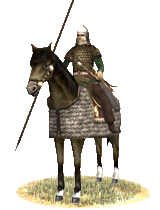 If many Roxolani riders can now equip themselves with corselets of scale armor, their nobility will take this trend one step further and provide defenses for the horses they ride as well. Protecting their mounts represents a substantial advantage for horsemen expected to charge headlong into the enemy, as horses, being a large target, are particularly vulnerable to missiles. In addition, when both horse and rider are armored, their momentum increases and their potential impact is greater. Thus, the charge of a group of Roxolani nobles is truly terrible and will often succeed in punching a hole in an enemy battle line that the rest of the warriors will be able to exploit. This does not mean that they constitute any of sort of "forlorn hope" or are particularly suicidal. Typically, they will first probe for weaknesses and, if none are readily found, they will work to create them. For such a task they may well resort to their bows, using archery to "soften" a spot prior to a charge. For an astute commander, they are a very valuable resource which should not be lightly squandered If many Roxolani riders can now equip themselves with corselets of scale armor, their nobility will take this trend one step further and provide defenses for the horses they ride as well. Protecting their mounts represents a substantial advantage for horsemen expected to charge headlong into the enemy, as horses, being a large target, are particularly vulnerable to missiles. In addition, when both horse and rider are armored, their momentum increases and their potential impact is greater. Thus, the charge of a group of Roxolani nobles is truly terrible and will often succeed in punching a hole in an enemy battle line that the rest of the warriors will be able to exploit. This does not mean that they constitute any of sort of "forlorn hope" or are particularly suicidal. Typically, they will first probe for weaknesses and, if none are readily found, they will work to create them. For such a task they may well resort to their bows, using archery to "soften" a spot prior to a charge. For an astute commander, they are a very valuable resource which should not be lightly squandered
Historically, only the richest Sarmatian chieftains were able to furnish complete sets of defensive equipment for both themselves and their horses. However, the impact, at least psychological, of such superbly equipped riders upon their enemies seems to have been much greater than what their numbers alone might have led to expect. Often, depictions of Sarmatians in battle produced by their enemies show masses of armoured horsemen. Archaeology and other sources indicate that this is a major overstatement, but such representations still probably hint about what most durably impressed the foes of the Sarmatians.
Voinu (Slavic Light Spearmen)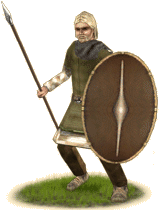 Voinu are fierce infantry spearmen who form the bulk of the armies of the Neuri and Boudinoi. They wear no armor, but their large, oval shields afford substantial protection and they are brave, wild warriors that make very tough opponents. In addition, they inhabit harsh terrain, forest, rivers and swamps, which is not suitable for cavalry warfare, but that they can use to their advantage. Therefore, their tactical doctrine was probably similar to that of their later descendants, the Central European Slavs, who lived and fought under similar conditions: the deployment of spearmen defended by big shields and backed by packs of skirmishers armed with sturdy bows. When in a favorable ground, the wild courage of these tribesmen and their terrifying reputation (the claims of their being cannibals appear to have had a solid basis) are added to the picture, the resulting combination is one than can prove very difficult to defeat. Voinu are fierce infantry spearmen who form the bulk of the armies of the Neuri and Boudinoi. They wear no armor, but their large, oval shields afford substantial protection and they are brave, wild warriors that make very tough opponents. In addition, they inhabit harsh terrain, forest, rivers and swamps, which is not suitable for cavalry warfare, but that they can use to their advantage. Therefore, their tactical doctrine was probably similar to that of their later descendants, the Central European Slavs, who lived and fought under similar conditions: the deployment of spearmen defended by big shields and backed by packs of skirmishers armed with sturdy bows. When in a favorable ground, the wild courage of these tribesmen and their terrifying reputation (the claims of their being cannibals appear to have had a solid basis) are added to the picture, the resulting combination is one than can prove very difficult to defeat.
Historically, Herodotos wrote about the Neuri and Boudinoi and placed them as northern neighbours of the European Scythians. Nowadays, many historians think they occupied the swamps and forests of Prippet and the upper Dnieper and associate them with advanced archeological cultures of the area. Features of those cultures are the use of iron weapons and a substantial influence from their southern Scythian neighbours. Some scholars consider the Neuri and Boudinoi the earliest known ancestors of the Proto-Slavs. In that case, their warrior class would have been plausibly called "Voinu", a proto-slavic word for "Warrior". In any case, they were fierce and wild opponents and cannibalism was apparently not foreign to them. Markings of teeth on human bones have been found in excavations and Herodotos wrote of the Androphagoi, the man-eaters. They are possibly the basis of the evil werewolves, man-eating wolf-people of later Slavic legend. In the historical past, whoever fought those tribes knew what terrible fate would befall them if they lost.
Skudra Tabari (Scythian Axemen)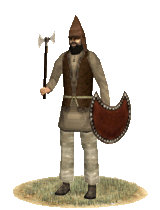 Armed with a Tabar axe, the primary offensive weapon of these infantrymen, they are protected with only the crescent shaped Taka shield and light armour. While unable to hold against most steppe cavalry, they can do deadly damage to some of the more "civilized" people’s inferior cavalry. But they would not last long against those same people’s massed heavy infantry. Despite some of their shortcomings, any steppe general would think twice before fighting a long campaign without these soldiers. Armed with a Tabar axe, the primary offensive weapon of these infantrymen, they are protected with only the crescent shaped Taka shield and light armour. While unable to hold against most steppe cavalry, they can do deadly damage to some of the more "civilized" people’s inferior cavalry. But they would not last long against those same people’s massed heavy infantry. Despite some of their shortcomings, any steppe general would think twice before fighting a long campaign without these soldiers.
Historically, despite all steppe peoples reliance on cavalry, most of them fielded infantry of some type at one time or another. In the case of the Scythians of the Pontic steppe, axemen were either recruited from subject farming peoples or from the growing proportion of settled Scythians, often young warriors from the tribes
Doryphoroi Pontikoi (Pontic Light Spearmen)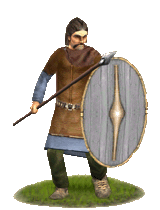 Doryphoroi Pontikoi are raised from peoples that live around the Azov Sea and the northern coast of the Black Sea and that have been subject to substantial Greek influence. This includes both original sedentary Maeotic and Sind tribes, settled groups of former nomads such as Scythians or the Sarmatian Siracae and also the Greek towns of the area. The non-Greek populations of the region have been long subject to substantial Greek influence, which is quite evident in, for example, the large oval shields of the thureos type that these infantrymen carry. That shield is typically their only protection. To it, they add spears and short swords. Thanks to their shields, they may face the many archers that their potential enemies are likely to field with some confidence and their spears allow them to fend off the light cavalry that is also common among their foes. They will also hold their ground against infantry similar to themselves. However, truly heavy cavalry, not to mention quality heavy infantry will get the better of them sooner rather than later. Doryphoroi Pontikoi are raised from peoples that live around the Azov Sea and the northern coast of the Black Sea and that have been subject to substantial Greek influence. This includes both original sedentary Maeotic and Sind tribes, settled groups of former nomads such as Scythians or the Sarmatian Siracae and also the Greek towns of the area. The non-Greek populations of the region have been long subject to substantial Greek influence, which is quite evident in, for example, the large oval shields of the thureos type that these infantrymen carry. That shield is typically their only protection. To it, they add spears and short swords. Thanks to their shields, they may face the many archers that their potential enemies are likely to field with some confidence and their spears allow them to fend off the light cavalry that is also common among their foes. They will also hold their ground against infantry similar to themselves. However, truly heavy cavalry, not to mention quality heavy infantry will get the better of them sooner rather than later.
Historically, by the 3rd century BC oval shields with long spines and spindle-shaped bosses spread and became common into the areas around the north coast of the Black Sea. The whole region had long maintained strong connections with the Greek world and this particular process followed military developments in the Hellenistic world. Infantry men equipped with oval shields and spears became common among the diverse ethnic groups that inhabited the region and for several centuries they formed part of the armies of a variety of nations including the Pontic and Bosporan kingdoms, Scythians and Sarmatians, Greek colonies of the area and Armenia.
Thureopherontes Toxotai (Bosphoran Heavy Archers)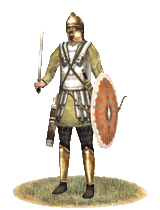 These soldiers are the epitome of Skythian and Hellenic fusion. While they wear Hellenic armour: a thureos shield, greaves, and Attico-Thracian helmet, their arms are Skythian: a bow and gorytos, and a Skythian longsword. They are among the wealthiest of the "Hellenized" class, able to afford multiple pieces of very expensive equipment, and are only eclipsed by the cavalry soldiers. They have trained extensively in archery, a tradition handed down among many on the north coast of the Pontos Euxeinos, and so may be expected to perform admirably against other missile units, few of which can match their armor level. Yet they are also well able to engage in melee, though a strategos would be unwise to send them to battle against fresh professional soldiers zealous for hand-to-hand combat. These soldiers are the epitome of Skythian and Hellenic fusion. While they wear Hellenic armour: a thureos shield, greaves, and Attico-Thracian helmet, their arms are Skythian: a bow and gorytos, and a Skythian longsword. They are among the wealthiest of the "Hellenized" class, able to afford multiple pieces of very expensive equipment, and are only eclipsed by the cavalry soldiers. They have trained extensively in archery, a tradition handed down among many on the north coast of the Pontos Euxeinos, and so may be expected to perform admirably against other missile units, few of which can match their armor level. Yet they are also well able to engage in melee, though a strategos would be unwise to send them to battle against fresh professional soldiers zealous for hand-to-hand combat.
Historically, the Bosporan Basileis, and the Pontic Basileis when they came to the north shores of the Euxeinos, desperately needed effective weapons against the skirmishing cavalry of the steppes. Foot archers were effective, but with their lack of armor, many of them were very much susceptible to both missiles and charges. The heavily-armed and armored archers are attested in both kingdom's armies through grave steles, and demonstrate the fusion between Hellenism and other cultures which characterized the social and military developments of the regions outside of the "traditional" Hellenic sphere.
|
 |
|
 |






















|